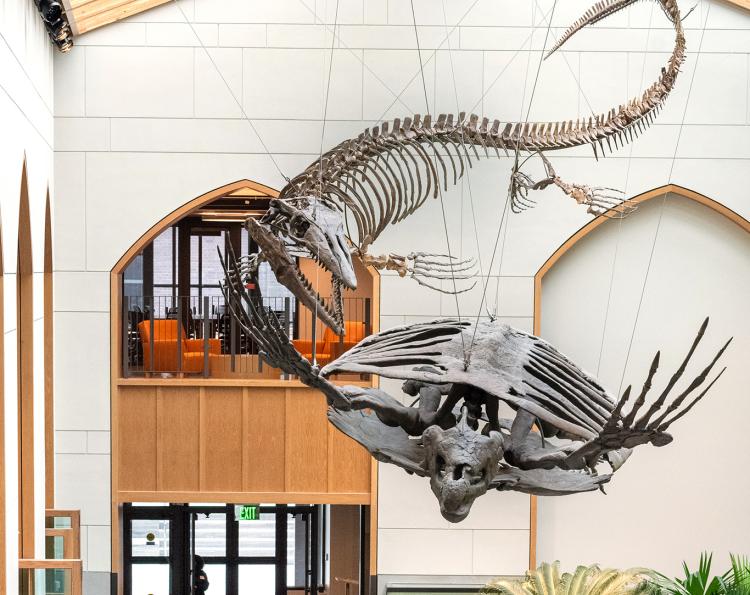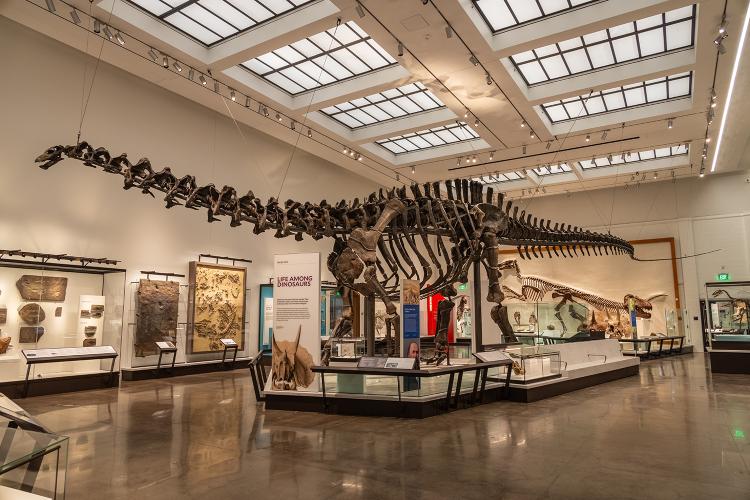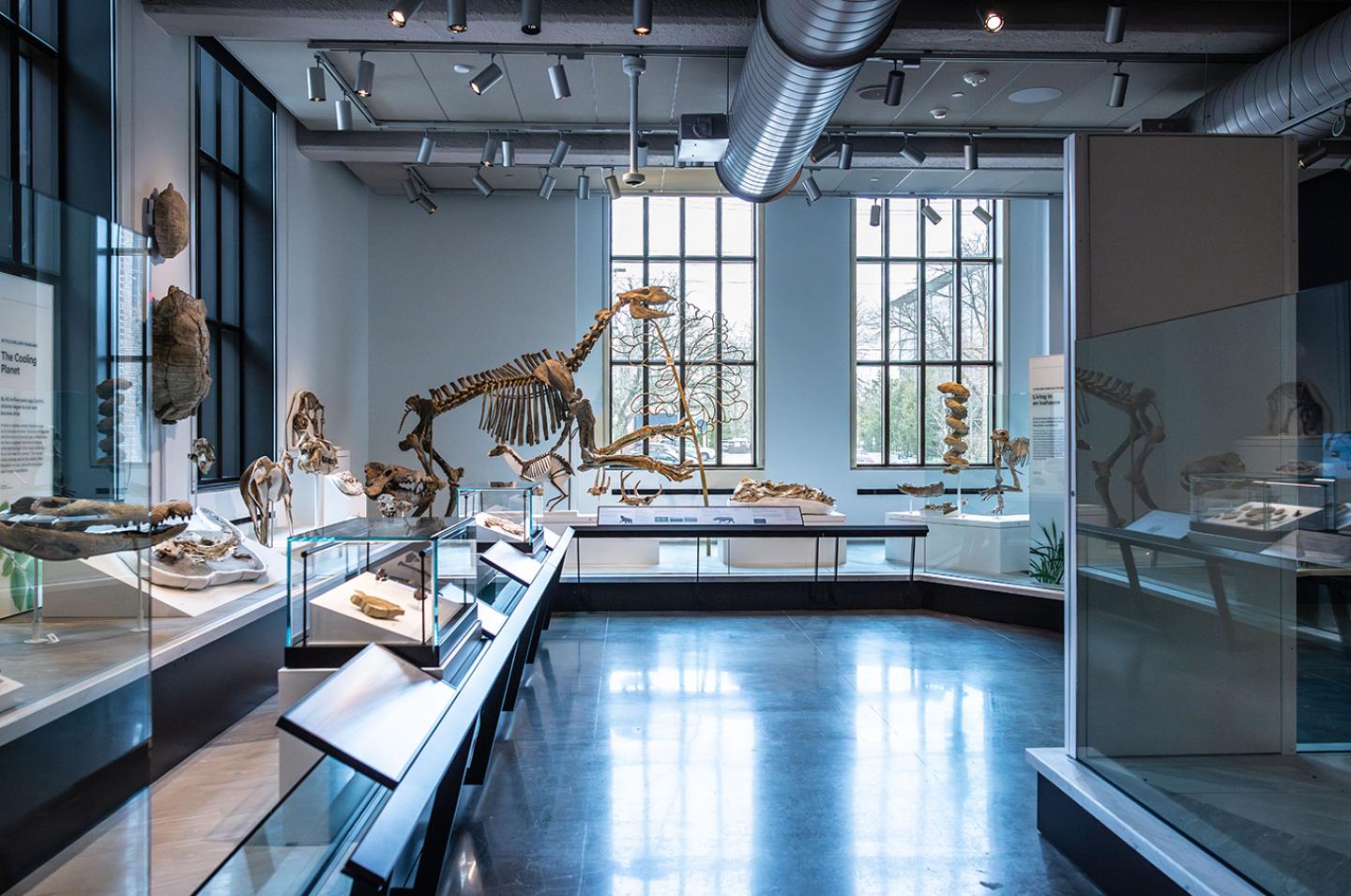Over four years ago, the Yale Peabody Museum closed its doors to undergo its most extensive renovation in a century. When the museum reopened on March 26, visitors found a familiar place transformed. Beloved specimens—the iconic Brontosaurus, the giant Archelon turtle, the arresting Olmec head—have been reassembled, restored, and recontextualized. Every exhibit has been updated, and the museum now boasts fifty percent more exhibition space. Brand-new galleries display specimens and objects never before shown at the museum, from sea scorpions to early microscopes. And admission to the Peabody is now free for all visitors.
“The Peabody has been brought into the twenty-first century,” says David Skelly, director of the Peabody Museum. The new exhibits—many of which hadn’t changed for decades—can now be easily updated, allowing them to evolve over time as researchers understand new things about the world. “In the future, as curators learn more, or as new curators come in, we can make sure we’re telling new stories here,” says Skelly.
Donors funded the Peabody’s transformation. The lead gift of $160 million from Edward P. Bass ’67 is one of the most generous gifts to Yale and the largest known gift to a natural history museum in this country. Dozens of other donors also supported the renovation. The main hall—home to the Brontosaurus, Stegosaurus, and the famous mural The Age of Reptiles—is now known as the Burke Hall of Dinosaurs, in recognition of a gift from Coleman P. Burke ’63 (who died in 2020) and the Coleman and Susan Burke Foundation.

A Revitalized Dinosaur Hall
“The old hall lacked a coherent narrative,” says Chris Norris, the Peabody’s director of public programs. “Now, we’re telling an adaptation-focused version of the history of life on Earth and highlighting the Yale research that has contributed to our understanding of that history.” Visitors first encounter fossils of ancient, invertebrate organisms, says Norris—a specialty of the Peabody’s collections, but previously only represented by a handful of specimens on display. Through fossils, pictures, and signs, visitors can learn about the adaptations that allowed animals to move from the water to the land and, eventually, to the air. The story continues into the next hall, where early mammals—including small horses, rhinoceros-like Megacerops, and strange, once-common oreodonts—appear alongside a life-like recreation of the eight-foot-tall bird Gastornis. Continuing further, visitors see more familiar animals, like a saber-toothed tiger, alongside fossil skulls of our early hominid ancestors.
Skelly cites the design firm Reich&Petch for their work on the new exhibits. “By giving them some light and air and remounting them, they’ve really brought these specimens to life for visitors while also reflecting state-of-the-art science,” he says.

Spaces for Students and Researchers
The museum’s new spaces will also benefit students and researchers. New climate-controlled classrooms will allow Yale students to interact directly with specimens from the museum’s extensive collections that aren’t on display. (While the museum displays about 2,000 specimens and objects, it holds another 14 million in its collections). Off of the new Central Gallery are five multi-use rooms, including the Alison F. Richard Study Gallery, named for the former director of the museum and former Yale provost, in recognition of a gift from an anonymous donor. Outside, a new entrance for the Yale community is located off a welcoming courtyard, Bass Court. It’s adorned by bronze casts of an extinct giant bison with huge, curving horns.
Ongoing research at the Peabody has also gotten a boost. New digitization technology will help curators scan and analyze some of the innumerable small insect specimens whose labels are on tiny microfiche. That kind of work with museum collections often occurs behind the scenes, out of view of the public, says Skelly. But the space where a new camera rig will be photographing each insect and its label will be visible to visitors as well.
Telling New Stories
On the second floor, more wonders await, including anthropological treasures from around the world, such as a Babylonian stone tablet billed as the world’s first cookbook. It contains recipes for stews, written in cuneiform. Nearby, an audio recording plays an interview with an Iraqi chef who came to Connecticut as a refugee, talking about the connections between food, family, and home. And a new sculpture by Syrian American artist and architect Mohamed Hafez uses 3D-printed versions of objects on display to create a mesmerizing, collage-like sculpture called Eternal Cities, inspired by his childhood in Damascus. “These are examples of the types of layered storytelling we’re bringing to the new Peabody,” says Kailen Rogers, the associate director of exhibitions at the museum.
The third floor houses the museum’s new Living Lab, where visitors will be able to see live insects, frogs, and plants. It also contains dioramas of Connecticut’s diverse wildlife and environments, showcasing lifelike scenes and meticulously painted backdrops, and David Friend Hall, the sparkling gem and mineral gallery named in honor of David Friend ’69.
A Museum for All
Beyond the elimination of admission fees, the Peabody has made other strides towards accessibility. Spanish-speaking tour guides lead several tours every week. Signs that explain the details of exhibits are written at a level meant to be understood by people of different ages, education levels, and learning abilities. Designers also prioritized physical accessibility, with ramps integrated into the museum’s exterior entryways and new, large elevators inside. Visitors won’t have to cross any streets to get to the entrance from the parking area, and there is a dedicated bus zone with a group entrance for visiting school groups. While some spaces are designed for quiet experiences, there are others where it’s “okay to be loud,” says Skelly.
“Accessibility comes in all sorts of different flavors,” adds Norris, the public programs director. “We’ve spent a lot of time and effort thinking about the different types of accessibility. The renovation allowed us to make major changes throughout to meet the needs of all our audiences.”
Inspiring Curiosity
“The Peabody Museum’s evolution extends our scientific research, our ability to teach, and our accessibility to visitors from all over the world,” President Peter Salovey ’86 PhD said at the Peabody’s dedication on April 17.
“If we’ve done our job right, we should be inspiring people’s curiosity,” says Skelly. A visitor can learn a lot from spending an hour or two in the museum, he says. “But if we’re really successful, the museum will lead people to something they didn’t even know existed and make them want to learn more. That’s what happened to me when I came to the Peabody as a kid.”
